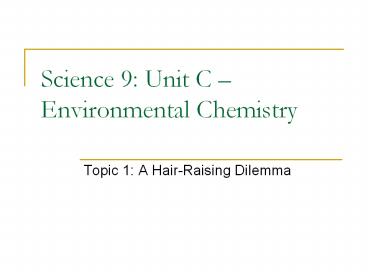Science 9: Unit C - PowerPoint PPT Presentation
1 / 8
Title: Science 9: Unit C
1
Science 9 Unit C Environmental Chemistry
- Topic 1 A Hair-Raising Dilemma
2
Nutrients Needed for Survival
- A nutrient is a chemical that our bodies need for
life. Our body needs many different chemicals to
survive. Most of these chemicals are obtained by
the digestion of food. The chemicals are
organized into two groups - Organic Compounds Compounds containing carbon
atoms. - Inorganic Compounds Compounds which do not
contain carbon. - There are four kinds of organic nutrients in the
body - Carbohydrates Sugars. Used for energy for life
processes. Contains carbon, hydrogen and oxygen. - Lipids Fats. Used to store unused energy for
later use. Larger than carbohydrates, but
containing the same elements. - Proteins/Amino Acids Used to help repair and
grow the bodys tissues. - Nucleic Acids DNA and RNA. Used for genetic
processes of the body. - The body needs 25 different elements to survive
and thrive. Some elements are needed in large
amounts (macrominerals), and others in very small
amounts (micronutrients or trace elements).
3
How Sugars are broken down into Glucose.
A molecule of Glucose C6H12O6(s)
- Hydrolysis A chemical reaction in which one or
more water molecules is chemically bonded to
another compound. This is how sugars and starches
are broken down into blood sugar (glucose).
4
Optimum Amounts
- Having too much or too little of any nutrient,
even a trace element can lead to harmful effects.
The optimum amount of a substance is the amount
that gives the organism the best health. - The Canada Food Guide informs the public to the
optimum amounts of various nutrients on a daily
basis.
5
How Nutrients Move through organisms.
- Nutrients enter the plant through the roots by
the process of diffusion. Diffusion is the
process where particles go from an area of high
to low concentration. Diffusion continues until
the concentrations in the soil and the plant are
equal. - Osmosis is a special type of diffusion where
water moves from an area of high to low
concentration of water. This is how a plant
drinks. Because diffusion and osmosis happen
automatically the plant uses no energy in either
process. - Active Transfer Some nutrients are required in
greater amounts than diffusion can supply so the
plant spends energy taking in these nutrients.
This process also serves another purpose by
restricting nutrients from competing plants. - Substrate Material that an organism attaches
itself to, moves through or lives off of. For
example the substrate of the Earthworm is soil.
6
The Food Cycle
- All living things need a constant supply of raw
materials and energy to survive and grow. The
food cycle begins with plants taking in inorganic
compounds and solar energy and chemically
changing them to organic compounds which
consumers use for energy, growth, and repair of
tissues.
7
Farming and Fertilizer
- Fertilizers are identified by three numbers (eg.
5-10-5). The first number represents the percent
of nitrogen, the second number the percent of
phosphate, and the third number the percent of
potassium. The other 80 of fertilizer is made up
of trace elements and filler. - Until 1900s plants received all of their nitrates
(nitrogen based nutrients) from nature (soil and
manure). Then commercial fertilizers were created
and the amount of nitrogen in the environment has
increased by 140 million tons/year. - Nitrogen is needed for tissue growth and repair
so plants have grown larger and healthier as more
nitrogen has become available. Crop production
has doubled worldwide.
8
The Problems with Modern Farming
- A lot of water is being used on farming.
Monoculture farming has led to a decrease in
genetic variety in plants making crops more at
risk for diseases. - Pests have increased as well and because of this,
the use of chemical pesticides has also increased.

